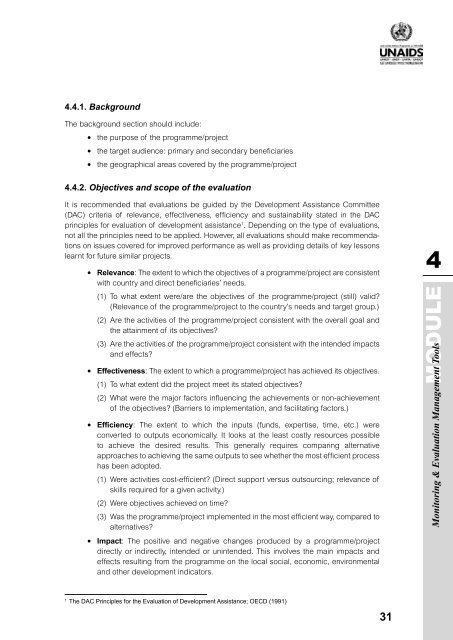Monitoring and Evaluation Modules - Global HIV M&E Information
Monitoring and Evaluation Modules - Global HIV M&E Information
Monitoring and Evaluation Modules - Global HIV M&E Information
Create successful ePaper yourself
Turn your PDF publications into a flip-book with our unique Google optimized e-Paper software.
4.4.1. Background<br />
The background section should include:<br />
• the purpose of the programme/project<br />
• the target audience: primary <strong>and</strong> secondary beneficiaries<br />
• the geographical areas covered by the programme/project<br />
4.4.2. Objectives <strong>and</strong> scope of the evaluation<br />
It is recommended that evaluations be guided by the Development Assistance Committee<br />
(DAC) criteria of relevance, effectiveness, efficiency <strong>and</strong> sustainability stated in the DAC<br />
principles for evaluation of development assistance 1 . Depending on the type of evaluations,<br />
not all the principles need to be applied. However, all evaluations should make recommendations<br />
on issues covered for improved performance as well as providing details of key lessons<br />
learnt for future similar projects.<br />
• Relevance: The extent to which the objectives of a programme/project are consistent<br />
with country <strong>and</strong> direct beneficiaries’ needs.<br />
(1) To what extent were/are the objectives of the programme/project (still) valid?<br />
(Relevance of the programme/project to the country’s needs <strong>and</strong> target group.)<br />
(2) Are the activities of the programme/project consistent with the overall goal <strong>and</strong><br />
the attainment of its objectives?<br />
(3) Are the activities of the programme/project consistent with the intended impacts<br />
<strong>and</strong> effects?<br />
• Effectiveness: The extent to which a programme/project has achieved its objectives.<br />
(1) To what extent did the project meet its stated objectives?<br />
(2) What were the major factors influencing the achievements or non-achievement<br />
of the objectives? (Barriers to implementation, <strong>and</strong> facilitating factors.)<br />
• Efficiency: The extent to which the inputs (funds, expertise, time, etc.) were<br />
converted to outputs economically. It looks at the least costly resources possible<br />
to achieve the desired results. This generally requires comparing alternative<br />
approaches to achieving the same outputs to see whether the most efficient process<br />
has been adopted.<br />
(1) Were activities cost-efficient? (Direct support versus outsourcing; relevance of<br />
skills required for a given activity.)<br />
(2) Were objectives achieved on time?<br />
(3) Was the programme/project implemented in the most efficient way, compared to<br />
alternatives?<br />
4<br />
MODULE<br />
<strong>Monitoring</strong> & <strong>Evaluation</strong> Management Tools<br />
• Impact: The positive <strong>and</strong> negative changes produced by a programme/project<br />
directly or indirectly, intended or unintended. This involves the main impacts <strong>and</strong><br />
effects resulting from the programme on the local social, economic, environmental<br />
<strong>and</strong> other development indicators.<br />
1<br />
The DAC Principles for the <strong>Evaluation</strong> of Development Assistance; OECD (1991)<br />
31















